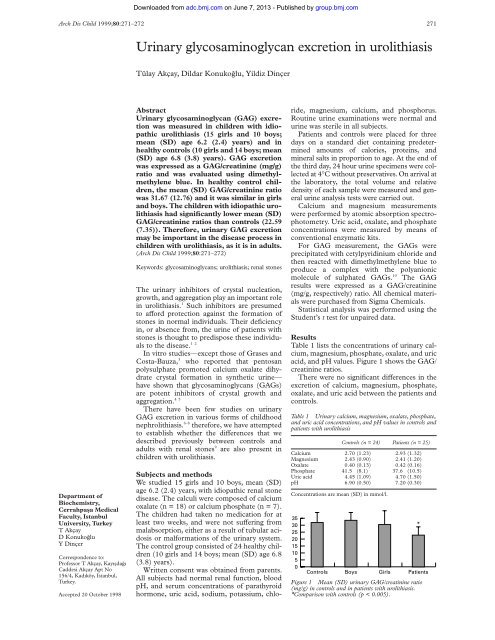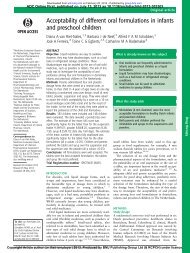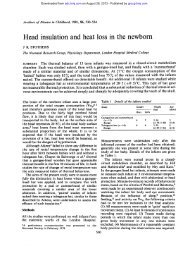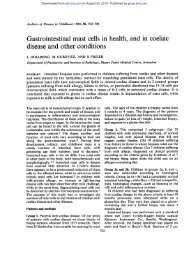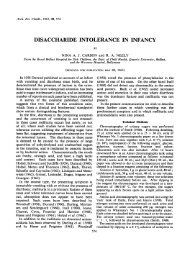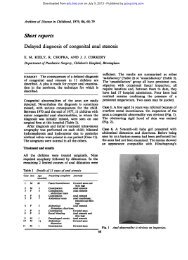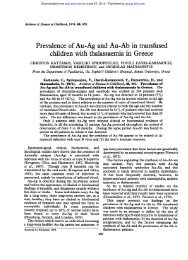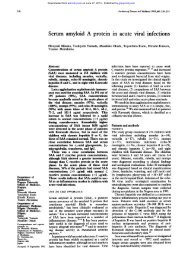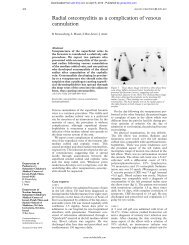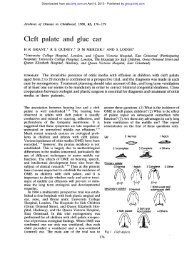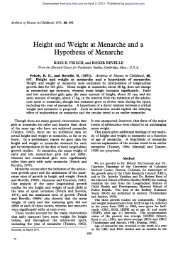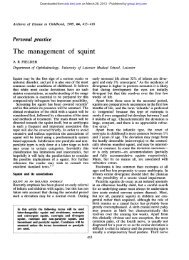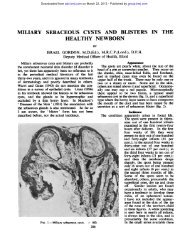Urinary glycosaminoglycan excretion in urolithiasis - Archives of ...
Urinary glycosaminoglycan excretion in urolithiasis - Archives of ...
Urinary glycosaminoglycan excretion in urolithiasis - Archives of ...
You also want an ePaper? Increase the reach of your titles
YUMPU automatically turns print PDFs into web optimized ePapers that Google loves.
Arch Dis Child 1999;80:271–272 271<br />
Department <strong>of</strong><br />
Biochemistry,<br />
Cerrahpas¸a Medical<br />
Faculty, Istanbul<br />
University, Turkey<br />
T Akçay<br />
D Konukog˘lu<br />
Y Dínçer<br />
Correspondence to:<br />
Pr<strong>of</strong>essor T Akçay, Kayıs¸dag˘ı<br />
Caddesi Akçay Apt No<br />
156/4, Kadıköy, Istanbul,<br />
Turkey.<br />
Accepted 20 October 1998<br />
Downloaded from<br />
adc.bmj.com on June 7, 2013 - Published by group.bmj.com<br />
<strong>Ur<strong>in</strong>ary</strong> <strong>glycosam<strong>in</strong>oglycan</strong> <strong>excretion</strong> <strong>in</strong> <strong>urolithiasis</strong><br />
Tülay Akçay, Díldar Konukog˘lu, Yildiz Dínçer<br />
Abstract<br />
<strong>Ur<strong>in</strong>ary</strong> <strong>glycosam<strong>in</strong>oglycan</strong> (GAG) <strong>excretion</strong><br />
was measured <strong>in</strong> children with idiopathic<br />
<strong>urolithiasis</strong> (15 girls and 10 boys;<br />
mean (SD) age 6.2 (2.4) years) and <strong>in</strong><br />
healthy controls (10 girls and 14 boys; mean<br />
(SD) age 6.8 (3.8) years). GAG <strong>excretion</strong><br />
was expressed as a GAG/creat<strong>in</strong><strong>in</strong>e (mg/g)<br />
ratio and was evaluated us<strong>in</strong>g dimethylmethylene<br />
blue. In healthy control children,<br />
the mean (SD) GAG/creat<strong>in</strong><strong>in</strong>e ratio<br />
was 31.67 (12.76) and it was similar <strong>in</strong> girls<br />
and boys. The children with idiopathic <strong>urolithiasis</strong><br />
had significantly lower mean (SD)<br />
GAG/creat<strong>in</strong><strong>in</strong>e ratios than controls (22.59<br />
(7.35)). Therefore, ur<strong>in</strong>ary GAG <strong>excretion</strong><br />
may be important <strong>in</strong> the disease process <strong>in</strong><br />
children with <strong>urolithiasis</strong>, as it is <strong>in</strong> adults.<br />
(Arch Dis Child 1999;80:271–272)<br />
Keywords: <strong>glycosam<strong>in</strong>oglycan</strong>s; <strong>urolithiasis</strong>; renal stones<br />
The ur<strong>in</strong>ary <strong>in</strong>hibitors <strong>of</strong> crystal nucleation,<br />
growth, and aggregation play an important role<br />
<strong>in</strong> <strong>urolithiasis</strong>. 1 Such <strong>in</strong>hibitors are presumed<br />
to aVord protection aga<strong>in</strong>st the formation <strong>of</strong><br />
stones <strong>in</strong> normal <strong>in</strong>dividuals. Their deficiency<br />
<strong>in</strong>, or absence from, the ur<strong>in</strong>e <strong>of</strong> patients with<br />
stones is thought to predispose these <strong>in</strong>dividu-<br />
als to the disease.<br />
1 2<br />
In vitro studies—except those <strong>of</strong> Grases and<br />
Costa-Bauza, 3 who reported that pentosan<br />
polysulphate promoted calcium oxalate dihydrate<br />
crystal formation <strong>in</strong> synthetic ur<strong>in</strong>e—<br />
have shown that <strong>glycosam<strong>in</strong>oglycan</strong>s (GAGs)<br />
are potent <strong>in</strong>hibitors <strong>of</strong> crystal growth and<br />
aggregation.<br />
4 5<br />
There have been few studies on ur<strong>in</strong>ary<br />
GAG <strong>excretion</strong> <strong>in</strong> various forms <strong>of</strong> childhood<br />
nephrolithiasis. 6–8 therefore, we have attempted<br />
to establish whether the diVerences that we<br />
described previously between controls and<br />
adults with renal stones 9 are also present <strong>in</strong><br />
children with <strong>urolithiasis</strong>.<br />
Subjects and methods<br />
We studied 15 girls and 10 boys, mean (SD)<br />
age 6.2 (2.4) years, with idiopathic renal stone<br />
disease. The calculi were composed <strong>of</strong> calcium<br />
oxalate (n = 18) or calcium phosphate (n = 7).<br />
The children had taken no medication for at<br />
least two weeks, and were not suVer<strong>in</strong>g from<br />
malabsorption, either as a result <strong>of</strong> tubular acidosis<br />
or malformations <strong>of</strong> the ur<strong>in</strong>ary system.<br />
The control group consisted <strong>of</strong> 24 healthy children<br />
(10 girls and 14 boys; mean (SD) age 6.8<br />
(3.8) years).<br />
Written consent was obta<strong>in</strong>ed from parents.<br />
All subjects had normal renal function, blood<br />
pH, and serum concentrations <strong>of</strong> parathyroid<br />
hormone, uric acid, sodium, potassium, chlo-<br />
ride, magnesium, calcium, and phosphorus.<br />
Rout<strong>in</strong>e ur<strong>in</strong>e exam<strong>in</strong>ations were normal and<br />
ur<strong>in</strong>e was sterile <strong>in</strong> all subjects.<br />
Patients and controls were placed for three<br />
days on a standard diet conta<strong>in</strong><strong>in</strong>g predeterm<strong>in</strong>ed<br />
amounts <strong>of</strong> calories, prote<strong>in</strong>s, and<br />
m<strong>in</strong>eral salts <strong>in</strong> proportion to age. At the end <strong>of</strong><br />
the third day, 24 hour ur<strong>in</strong>e specimens were collected<br />
at 4°C without preservatives. On arrival at<br />
the laboratory, the total volume and relative<br />
density <strong>of</strong> each sample were measured and general<br />
ur<strong>in</strong>e analysis tests were carried out.<br />
Calcium and magnesium measurements<br />
were performed by atomic absorption spectrophotometry.<br />
Uric acid, oxalate, and phosphate<br />
concentrations were measured by means <strong>of</strong><br />
conventional enzymatic kits.<br />
For GAG measurement, the GAGs were<br />
precipitated with cetylpyrid<strong>in</strong>ium chloride and<br />
then reacted with dimethylmethylene blue to<br />
produce a complex with the polyanionic<br />
molecule <strong>of</strong> sulphated GAGs. 10 The GAG<br />
results were expressed as a GAG/creat<strong>in</strong><strong>in</strong>e<br />
(mg/g, respectively) ratio. All chemical materials<br />
were purchased from Sigma Chemicals.<br />
Statistical analysis was performed us<strong>in</strong>g the<br />
Student’s t test for unpaired data.<br />
Results<br />
Table 1 lists the concentrations <strong>of</strong> ur<strong>in</strong>ary calcium,<br />
magnesium, phosphate, oxalate, and uric<br />
acid, and pH values. Figure 1 shows the GAG/<br />
creat<strong>in</strong><strong>in</strong>e ratios.<br />
There were no significant diVerences <strong>in</strong> the<br />
<strong>excretion</strong> <strong>of</strong> calcium, magnesium, phosphate,<br />
oxalate, and uric acid between the patients and<br />
controls.<br />
Table 1 <strong>Ur<strong>in</strong>ary</strong> calcium, magnesium, oxalate, phosphate,<br />
and uric acid concentrations, and pH values <strong>in</strong> controls and<br />
patients with <strong>urolithiasis</strong><br />
Controls (n = 24) Patients (n = 25)<br />
Calcium 2.70 (1.23) 2.93 (1.32)<br />
Magnesium 2.43 (0.90) 2.41 (1.20)<br />
Oxalate 0.40 (0.13) 0.42 (0.16)<br />
Phosphate 41.5 (8.1) 37.6 (10.5)<br />
Uric acid 4.45 (1.09) 4.70 (1.50)<br />
pH 6.90 (0.50) 7.20 (0.30)<br />
Concentrations are mean (SD) <strong>in</strong> mmol/l.<br />
35<br />
30<br />
25<br />
20<br />
15<br />
10<br />
5<br />
*<br />
0<br />
Controls Boys Girls Patients<br />
Figure 1 Mean (SD) ur<strong>in</strong>ary GAG/creat<strong>in</strong><strong>in</strong>e ratio<br />
(mg/g) <strong>in</strong> controls and <strong>in</strong> patients with <strong>urolithiasis</strong>.<br />
*Comparison with controls (p < 0.005).
Downloaded from<br />
adc.bmj.com on June 7, 2013 - Published by group.bmj.com<br />
272 Akçay, Konukog˘lu, Dínçer<br />
The control subjects had a mean (SD)<br />
GAG/creat<strong>in</strong><strong>in</strong>e ratio <strong>of</strong> 31.67 (12.76). We<br />
found no diVerences between girls and boys <strong>in</strong><br />
mean (SD) ur<strong>in</strong>ary GAG/creat<strong>in</strong><strong>in</strong>e ratio<br />
(33.34 (9.43), 30.39 (14.69), respectively). In<br />
patients, the mean (SD) ur<strong>in</strong>ary GAG/<br />
creat<strong>in</strong><strong>in</strong>e ratio was significantly lower (22.59<br />
(7.35)) than <strong>in</strong> control subjects (p < 0.005).<br />
Discussion<br />
In adults with calcium stones a higher ur<strong>in</strong>ary<br />
<strong>excretion</strong> <strong>of</strong> calcium, oxalate, and urate as well<br />
as a deficiency <strong>in</strong> <strong>in</strong>hibit<strong>in</strong>g substances has<br />
been reported repeatedly. There have been<br />
numerous reports show<strong>in</strong>g that ur<strong>in</strong>ary GAGs<br />
are low <strong>in</strong> adult patients with nephrolithiasis.<br />
1 3 11 12 We also found that ur<strong>in</strong>ary GAG<br />
concentrations were significantly lower <strong>in</strong><br />
adults with <strong>urolithiasis</strong>. 9 However, although<br />
Michelacci et al suggested that ur<strong>in</strong>ary GAG<br />
<strong>excretion</strong> <strong>in</strong> children with <strong>urolithiasis</strong> was<br />
significantly lower, 6 these data have not been<br />
confirmed by others.<br />
7 8<br />
The mean (SD) ur<strong>in</strong>ary GAG concentrations<br />
<strong>in</strong> 15 healthy children were reported as<br />
17.00 (15.60) mg/day by Lama et al. 7 However,<br />
Baggio et al reported that the mean (SD) GAG<br />
concentrations <strong>in</strong> healthy children were 61.26<br />
(17.94) mg/l and found no significant diVerence<br />
<strong>in</strong> ur<strong>in</strong>ary GAG <strong>excretion</strong> between<br />
children with idiopathic <strong>urolithiasis</strong> and<br />
healthy controls. 8 Michelacci et al reported a<br />
mean (SD) GAG/creat<strong>in</strong><strong>in</strong>e (mg/g) ratio <strong>of</strong><br />
24.33 (1.91) <strong>in</strong> healthy children 6 ; this result is<br />
close to our f<strong>in</strong>d<strong>in</strong>gs <strong>of</strong> 31.67 (12.76).<br />
Discrepancies between data from diVerent<br />
studies might be caused by the diVerent methods<br />
used to measure GAGs. In the literature,<br />
the measurement <strong>of</strong> ur<strong>in</strong>ary GAG concentrations<br />
is commonly performed by the<br />
borate−carbazole method or other procedures<br />
<strong>in</strong>volv<strong>in</strong>g the basic metachromatic dye, alcian<br />
blue. The borate−carbazole method measures<br />
the hexuronic acid residues <strong>of</strong> GAG molecules<br />
and, therefore, cannot detect keratan sulphate<br />
because the hexuronic acid residues are<br />
replaced with galactose <strong>in</strong> keratan sulphate. 10<br />
In addition, other procedures <strong>in</strong>volv<strong>in</strong>g the use<br />
<strong>of</strong> alcian blue are not specific for ur<strong>in</strong>ary GAGs<br />
because negatively charged molecules, other<br />
than sulphated GAGs, <strong>in</strong>terfere with the<br />
assay. 13 F<strong>in</strong>ely dispersed precipitates obta<strong>in</strong>ed<br />
with alcian blue are <strong>of</strong>ten diYcult to<br />
harvest. 13 14 On the other hand, Hesse et al<br />
<strong>in</strong>dicated that there was a diurnal rhythm <strong>in</strong><br />
ur<strong>in</strong>ary GAG <strong>excretion</strong>. 15 As GAG <strong>excretion</strong><br />
was highest <strong>in</strong> the morn<strong>in</strong>g and lowest at night,<br />
24 hour ur<strong>in</strong>e collection would avoid falsely<br />
high results. Therefore, we performed the<br />
GAG measurements <strong>in</strong> 24 hour ur<strong>in</strong>e specimens<br />
and we also calculated total GAG<br />
concentration by us<strong>in</strong>g the GAG/creat<strong>in</strong><strong>in</strong>e<br />
ratio <strong>in</strong> 24 hour ur<strong>in</strong>e samples, which gives<br />
more reliable results. 16<br />
A procedure <strong>in</strong>volv<strong>in</strong>g the use <strong>of</strong> the basic<br />
metachromatic dye dimethylene blue, which<br />
we used for the first time to determ<strong>in</strong>e GAG<br />
concentrations <strong>in</strong> the ur<strong>in</strong>e <strong>of</strong> children with<br />
stones, is reported to be more sensitive than the<br />
other methods used to analyse ur<strong>in</strong>ary GAG<br />
concentrations <strong>in</strong> patients with <strong>urolithiasis</strong>. 12<br />
Our data lead us to propose that ur<strong>in</strong>ary<br />
GAG may play an important role <strong>in</strong> the<br />
prevention and reduction <strong>of</strong> calculi <strong>in</strong> children,<br />
as has been found <strong>in</strong> adults. 9<br />
The authors thank the Department <strong>of</strong> Paediatrics <strong>of</strong> Cerrahpas¸a<br />
Medical School for their cl<strong>in</strong>ical assistance.<br />
1 S<strong>in</strong>dhu H, Hemal A K, Th<strong>in</strong>d S, Rath R, Vaidyanathan S.<br />
Comparative study <strong>of</strong> 24 hours ur<strong>in</strong>ary <strong>excretion</strong> <strong>of</strong><br />
<strong>glycosam<strong>in</strong>oglycan</strong> by renal stone formers and healthy<br />
adults. Eur Urol 1989;16:45–7.<br />
2 Akçay T, Konukog˘lu D, Çelik Ç. Hypocitraturia <strong>in</strong> patients<br />
with urulithiasis. Arch Dis Child 1996;74:350–1.<br />
3 Grases F, Costa-Bauza A. Study <strong>of</strong> factors aVect<strong>in</strong>g calcium<br />
oxalate crystall<strong>in</strong>e aggregation. BrJUrol1990;66:240–4.<br />
4 Fellstrim B, Danielson BG, Karlsson FA, Ljunghall S. Crystal<br />
<strong>in</strong>hibition: b<strong>in</strong>d<strong>in</strong>g <strong>of</strong> hepar<strong>in</strong> and chondroit<strong>in</strong> sulphates,<br />
hepar<strong>in</strong>, pentosan polysulphate and Tamm-Hosfall<br />
glycoprote<strong>in</strong>. Urol Res 1984;12:81–3.<br />
5 Kohri K, Garisde Y, Blacklock NJ. The eVect <strong>of</strong> <strong>glycosam<strong>in</strong>oglycan</strong>s<br />
on the crystallisation <strong>of</strong> calcium oxalate.<br />
BrJUrol1989;63:584–90.<br />
6 Michelacci MY, Glashan BQ, Schor N. <strong>Ur<strong>in</strong>ary</strong> <strong>excretion</strong> <strong>of</strong><br />
<strong>glycosam<strong>in</strong>oglycan</strong>s <strong>in</strong> normal and stone form<strong>in</strong>g subjects.<br />
Kidney Int 1989;36:1022–8.<br />
7 Lama G, Gariella Carbone M, Marrone N, Russo P, Spagnuolu<br />
G. Promoters and <strong>in</strong>hibitors <strong>of</strong> calcium <strong>urolithiasis</strong> <strong>in</strong><br />
children. Child Nephrol Urol 1994;10:81–4.<br />
8 Baggio B, Gambro G, Favaro S, et al. Juvenile renal stone<br />
disease: a study <strong>of</strong> ur<strong>in</strong>ary promot<strong>in</strong>g and <strong>in</strong>hibit<strong>in</strong>g<br />
factors. J Urol 1981;130:1133−5.<br />
9 Akçay T, Erbas¸ M, Konukog˘lu D. <strong>Ur<strong>in</strong>ary</strong> <strong>excretion</strong> <strong>of</strong> <strong>glycosam<strong>in</strong>oglycan</strong>s<br />
<strong>in</strong> normal <strong>in</strong>dividuals and patients with<br />
renal stones. Med Sci Res 1994;22:77–8.<br />
10 Pann<strong>in</strong> G, Naia S, Dallw’Amica R, Chlandetti L, Zachello<br />
F, Catassi C. Simple spectrophotometric quantification <strong>of</strong><br />
ur<strong>in</strong>ary <strong>excretion</strong> <strong>of</strong> <strong>glycosam<strong>in</strong>oglycan</strong> sulphates. Cl<strong>in</strong><br />
Chem 1986;32:2073–6.<br />
11 Nikkila M. <strong>Ur<strong>in</strong>ary</strong> <strong>glycosam<strong>in</strong>oglycan</strong>s <strong>excretion</strong> <strong>in</strong> normal<br />
and stone-form<strong>in</strong>g subjects. Significant disturbance <strong>in</strong><br />
recurrent stone formers. Urol Int 1989;44:157–9.<br />
12 Jong JGN, Wevers RA, Laarakkers C, Poortuis BJHM.<br />
Dimethylmethylene blue-based spectrophotometry <strong>of</strong> <strong>glycosam<strong>in</strong>oglycan</strong>s<br />
<strong>in</strong> untreated ur<strong>in</strong>e: a rapid screen<strong>in</strong>g procedure<br />
for mucopolysaccharidoses. Cl<strong>in</strong> Chem 1989;35:<br />
1472–7.<br />
13 Whitley CB, Ridnour MD, Draper KA, Dutton CM, Neglia<br />
JP. Diagnostic test for mucopolysaccharidoses I. Direct<br />
method for quantify<strong>in</strong>g excessive ur<strong>in</strong>ary <strong>glycosam<strong>in</strong>oglycan</strong><br />
<strong>excretion</strong>. Cl<strong>in</strong> Chem 1989;35:374–9.<br />
14 Pennock CA. A review and selection <strong>of</strong> simple laboratory<br />
methods used for the study <strong>of</strong> <strong>glycosam<strong>in</strong>oglycan</strong> <strong>excretion</strong><br />
and diagnosis <strong>of</strong> the mucopolysaccharidoses. J Cl<strong>in</strong> Pathol<br />
1976;29:111–23.<br />
15 Hesse A, Wuzel H, Vanlensieck W. The <strong>excretion</strong> <strong>of</strong><br />
<strong>glycosam<strong>in</strong>oglycan</strong>s <strong>in</strong> the ur<strong>in</strong>e <strong>of</strong> calcium-oxalate-stone<br />
patients and healthy persons. Urology 1986;41:81–7.<br />
16 Goldberg JM, Catlier E. Specific isolation and analysis <strong>of</strong><br />
mucopolysaccharides (<strong>glycosam<strong>in</strong>oglycan</strong>) from human<br />
ur<strong>in</strong>e. Cl<strong>in</strong> Chem Acta 1984;41:19–21.
References<br />
Email alert<strong>in</strong>g<br />
service<br />
Topic<br />
Collections<br />
Notes<br />
<strong>Ur<strong>in</strong>ary</strong> <strong>glycosam<strong>in</strong>oglycan</strong> <strong>excretion</strong> <strong>in</strong><br />
<strong>urolithiasis</strong><br />
Tülay Akçay, Díldar Konukoglu and Yildiz Dínçer<br />
Arch Dis Child 1999 80: 271-272<br />
doi: 10.1136/adc.80.3.271<br />
Updated <strong>in</strong>formation and services can be found at:<br />
http://adc.bmj.com/content/80/3/271.full.html<br />
These <strong>in</strong>clude:<br />
This article cites 12 articles, 5 <strong>of</strong> which can be accessed free at:<br />
http://adc.bmj.com/content/80/3/271.full.html#ref-list-1<br />
Article cited <strong>in</strong>:<br />
http://adc.bmj.com/content/80/3/271.full.html#related-urls<br />
Receive free email alerts when new articles cite this article. Sign up <strong>in</strong> the<br />
box at the top right corner <strong>of</strong> the onl<strong>in</strong>e article.<br />
Articles on similar topics can be found <strong>in</strong> the follow<strong>in</strong>g collections<br />
Urology (295 articles)<br />
To request permissions go to:<br />
http://group.bmj.com/group/rights-licens<strong>in</strong>g/permissions<br />
To order repr<strong>in</strong>ts go to:<br />
http://journals.bmj.com/cgi/repr<strong>in</strong>tform<br />
To subscribe to BMJ go to:<br />
http://group.bmj.com/subscribe/<br />
Downloaded from<br />
adc.bmj.com on June 7, 2013 - Published by group.bmj.com


